Patrimony in Peril: Germany’s Survey of Mural Paintings Threatened During World War II

Cardboard and metal mounts hold Agfacolor film between two pieces of glass in these original 1943/1945 slides. The center slide shows the nineteenth-century murals in Joseph Goebbels’ Propaganda Ministry in Berlin.

A survey photographer from Berlin, probably Peter Cürlis (1924–1997), is seen reflected in the mirror at far left, standing on a ladder with his camera. Potsdam (Brandenburg, Germany). Stadtschloss, apartment of Frederick the Great, writing cabinet decorations above doorway on north wall (overall on right, detail on left). (Photo by Peter Cürlis, 1943)

Berlin (Germany). Reichsministerium für Volksaufklärung und Propaganda (formerly Palais des Prinzen Karl and Ordenspalais). The palace was built in 1737 and remodeled by Karl Friedrich Schinkel (1781–1841) from 1827 to 1828. In 1933 it became Joseph Goebbels’ propaganda ministry, and later it served as the administrative headquarters for the mural paintings survey. The palace was located on the north side of Wilhelms-Platz, which was also the location of the Reich Chancellery and Hitler’s bunker. The palace was destroyed in 1945. (Rare Postcard Collection)

Berlin (Germany). Reichsministerium für Volksaufklärung und Propaganda (formerly Palais des Prinzen Karl and Ordenspalais), Throne Room. Karl Friedrich Schinkel (1781–1841), Antique Cycle. These painted friezes continued around the perimeter of the room.
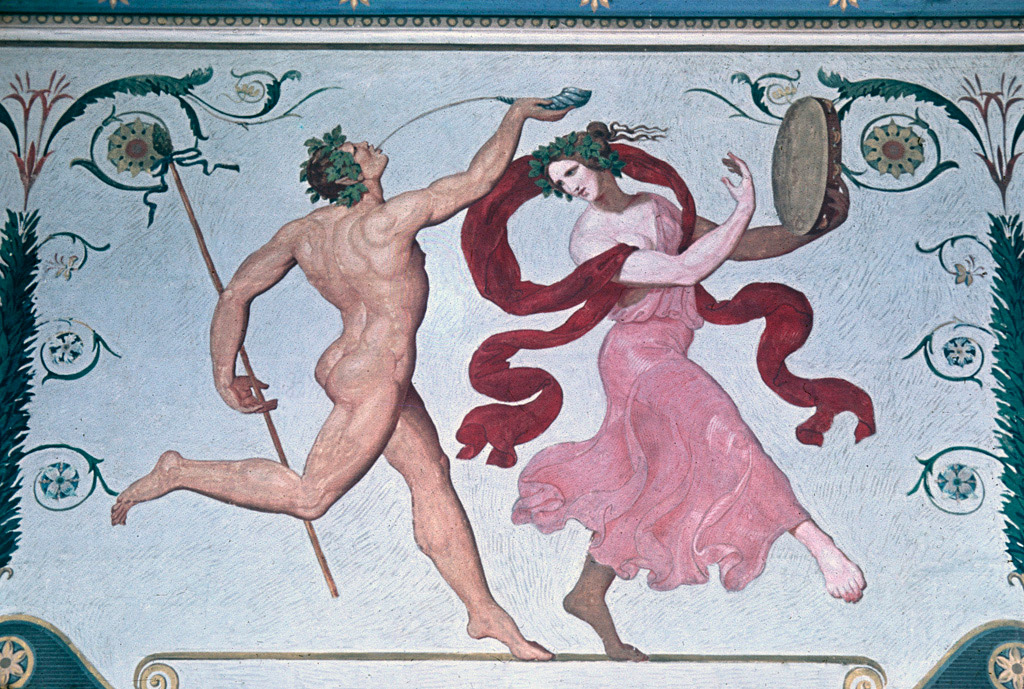
Berlin (Germany). Reichsministerium für Volksaufklärung und Propaganda (formerly Palais des Prinzen Karl and Ordenspalais), Throne Room. Karl Friedrich Schinkel (1781–1841), Antique Cycle, Dionysus and Courtesan Dancing, detail of the mural frieze.

Berlin (Germany). Reichsministerium für Volksaufklärung und Propaganda (formerly Palais des Prinzen Karl and Ordenspalais), Pompeiian Room. Karl Friedrich Schinkel (1781–1841), Mythological Cycle, Europa on the Bull, detail of wall decoration.

Berlin (Germany). Altes Museum. This neoclassical building on the north side of the Lustgarten was originally designed by Karl Friedrich Schinkel (1781–1841) for the Prussian royal family’s art collection and later became a state museum. It was built from 1824 to 1828 and damaged in 1945. (Wethey Rare Postcard Collection)
For the building’s history, see Image Collections' Holdings.

Berlin (Germany). Altes Museum, Vestibule. Bernhard Wilhelm Rosendahl (1804–1846), Scenes after Etruscan Wall Paintings. This mural cycle represents the progression of the world from chaos to civilization. The mural was destroyed in 1945.

Berlin (Germany). Altes Museum, Upper Vestibule. Cycle of Human Life, Men Bringing Ram and Offerings to the Altar. These frescoes were designed by Karl Friedrich Schinkel (1781–1841) and represent the struggle of mankind against barbarians and the elements. This fresco was destroyed in 1945.

Berlin (Germany). Altes Museum, Upper Vestibule. Cycle of Human Life, Vase Painter and Draftsman. These frescoes were designed by Karl Friedrich Schinkel (1781–1841) and represent the peaceful avocations of civilization. They were destroyed in 1945.

Berlin (Germany). Neues Museum, on right, behind Schinkel’s Customs House. Designed by Friedrich August Stüler (1800–1865), a student of Karl Friedrich Schinkel (1781–1841), and built from 1843 to 1855, the building was recognized for its artistic internal decorations. It was damaged during bombing of Berlin. (Foto Marburg, detail)
For the building’s history, see Image Collections' Holdings.

Berlin (Germany). Neues Museum, Niobid Gallery. Scenes from Classical Literature and Mythology, partial view of mural cycle. The murals were partially destroyed during the bombing of Berlin.
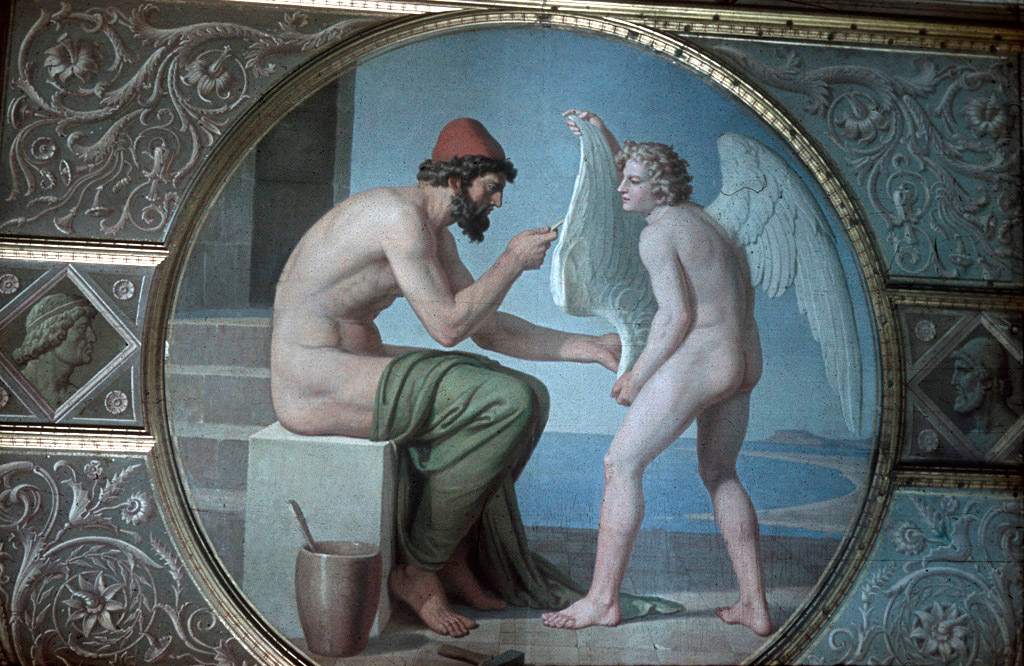
Berlin (Germany). Neues Museum, Niobid Gallery. Bonaventura Genelli (1798–1868), Daedalus Constructs Wings for Icarus. The murals were partially destroyed during the bombing of Berlin.

Berlin (Germany). Neues Museum, Dome Hall. Hermann Anton Stilke (1803–1860), Christianity Adopted as the Religion of the State. This work in the barrel vault was part of a cycle of paintings that were partially destroyed in the bombing of Berlin.

Berlin (Germany). Neues Museum, Dome Hall. Perseus Frees Andromeda, partial view of mural cycle. This mural was destroyed during the bombing of Berlin.
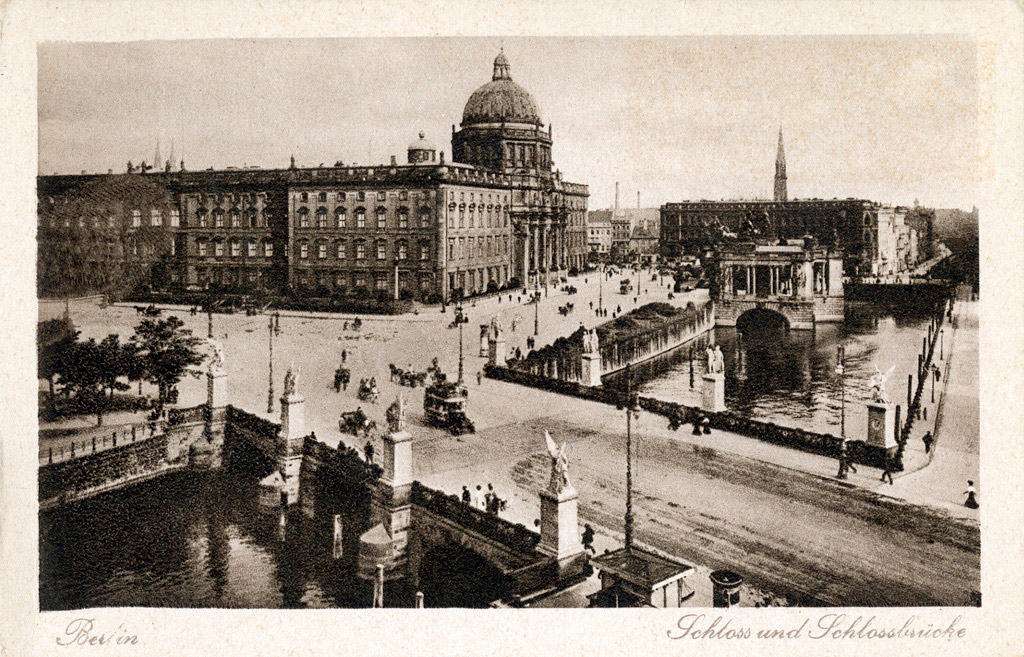
Berlin (Germany). Stadtschloß. Built from 1443 to 1716, this palace was heavily damaged by Allied bombing in 1945, and demolished by the GDR in 1951. (Rare Postcard Collection)

Berlin (Germany). Stadtschloß, Knights’ Hall (Old Throne Room), nineteenth-century albumen print from glass collodion negative. (Gramstorff Collection)
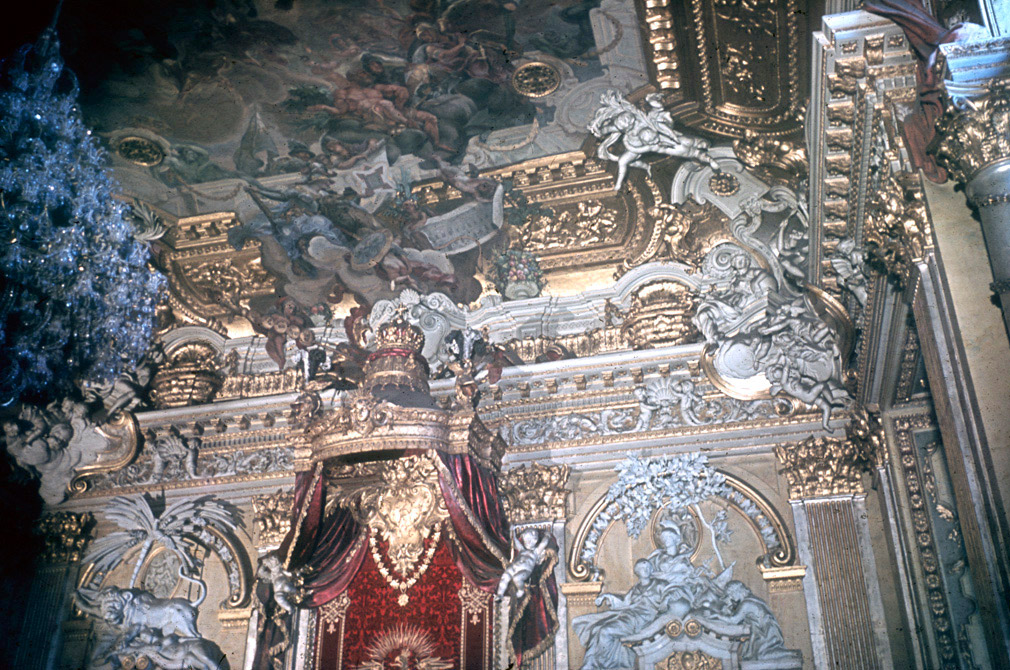
Berlin (Germany). Stadtschloß, Knights’ Hall, throne canopy topped by a magnificent crown and intricate vault and wall decorations. Martin Luther stood under this crystal chandelier when he addressed the Diet of Worms in 1521. The chandelier was purchased from the City of Worms by Frederick William III and installed in the Stadtschloß. (Photo by Peter Cürlis, 1943/1945)

Berlin (Germany). Stadtschloß, Knights’ Hall. Johann Friedrich Wentzel (1670–1729), Assembly of Olympian Gods, ceiling painting, and the solid silver musicians’ balcony. The Farbdiaarchiv slides of the Stadtschloß provide possibly the only color images ever taken of the interior of the massive palace. (Photo by Peter Cürlis, 1943/1945)

Blaubeuren (Baden-Württemberg, Germany). Kloster Blaubeuren, Bathhouse. Peter Struv (active c. 1514), Illusionistic Arbor with Hunting Scenes. This view depicts murals in the Benedictine monastery bathhouse, created around 1510. The house is constructed in the fachwerk style, with post, beam, and infill. (Photo by Helga Schmidt-Glassner, 1944)
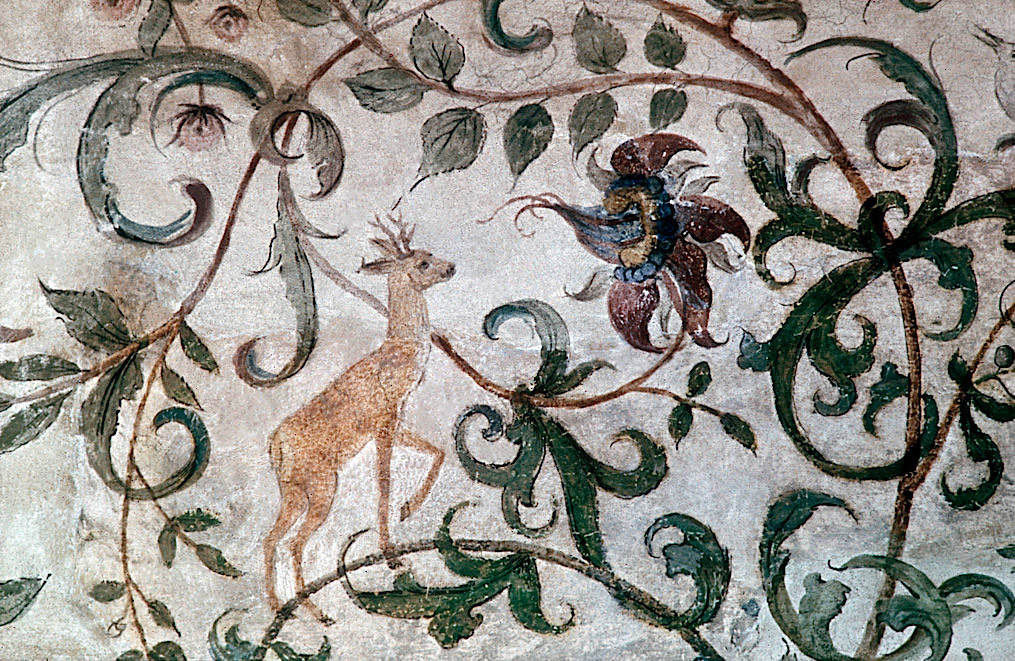
Blaubeuren (Baden-Württemberg, Germany). Kloster Blaubeuren, Bathhouse. Peter Struv (active c. 1514), Illusionistic Arbor with Hunting Scenes, Young Buck. This mural is in the Benedictine monastery bathhouse, created around 1510. (Photo by Helga Schmidt-Glassner, 1944)
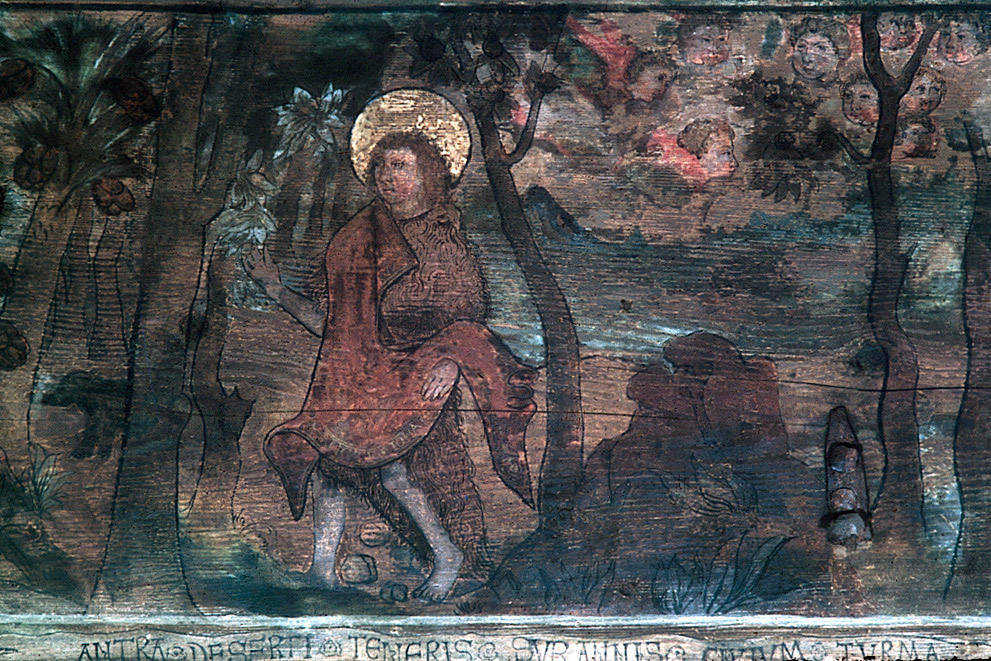
Blaubeuren (Baden-Württemberg, Germany). Kloster Blaubeuren, Bathhouse, central beam west side. Peter Struv (active c. 1514), John the Baptist in the Desert (History of John the Baptist cycle). (Photo by Helga Schmidt-Glassner, 1944)

Blaubeuren (Baden-Württemberg, Germany). Kloster Blaubeuren, Margaret Chapel, south wall, first section. Bernhard Strigel (1460/1461–1528), Martyrdom of St. Margaret, Angels with the Instruments of Martyrdom (cycle). (Photo by Helga Schmidt-Glassner, 1944)

Bruchsal (Baden-Württemberg, Germany). Schloß, staircase. This palace was constructed from 1722 to 1770 as a residence for the Prince-Bishops of Speyer, the only ecclesiastic complex of its kind on the upper Rhine. It is known for the opulent staircase by Balthasar Neumann (1687–1753), who also designed the staircase in the residence of the Prince-Bishops of Würzburg. The palace was destroyed March 1, 1945, but was later restored. (Postcard from the Rudolf Wittkower Collection)
For images of the war-damaged palace, see Image Collections’ holdings and the Monuments Men web feature.

Bruchsal (Baden-Württemberg, Germany). Schloß, staircase dome fresco. Januarius Zick (1730–1797), History of the Speyer Diocese, 1751–1754. (Photo by Helga Schmidt-Glassner, 1943/1945)

Bruchsal (Baden-Württemberg, Germany). Schloß, staircase dome fresco. Januarius Zick (1739–1797), History of the Speyer Diocese, 1751–1754. After his plans to rebuild the residence attached to Speyer Cathedral were thwarted by Protestant municipal authorities, Prince-Bishop Damian Hugo Schönborn (1676–1743) decided to build an entirely new palace in Bruchsal, 25 km to the south. In this fresco, Damian Hugo plans the new palace with his architects and building contractors beneath a host of allegorical and mythological figures. (Photo by Helga Schmidt-Glassner, 1943/1945)

Bruchsal (Baden-Württemberg, Germany). Schloß, Hofkirche. Cosmas Damian Asam (1686–1739), The Legend of Saints Cosmas and Damian, 1730, nave ceiling fresco. Prince-Bishop Damian Hugo spared no expense when he hired one of Germany’s most celebrated fresco artists to decorate the church in the south wing of the new palace. (Photo by Helga Schmidt-Glassner, 1943/1945)

Bruchsal (Baden-Württemberg, Germany). Schloß, Hofkirche. Cosmas Damian Asam (1686-1739), Saint Luke the Evangelist, 1730, pendentive fresco. After their total destruction in 1945, the frescoes by Asam were not reconstructed when the church was rebuilt in a spare, modern style in the 1960s. (Photo by Helga Schmidt-Glassner, 1943/1945)

Dresden (Sachsen, Germany). Frauenkirche, south façade. Built from 1726 to 1743, the Frauenkirche was destroyed by Allied bombing in 1945, but rebuilt from 1996 to 2005. Slides showing the eighteenth-century inner dome frescoes in the Zentralinstitut’s Farbdiaarchiv were used as templates when the frescoes were reconstructed.
For views of the rebuilt Frauenkirche, see Image Collections' holdings.

Ingolstadt (Bayern, Germany). St. Maria de Victoria Kirche (Asam Kirche), interior view of nave. Built from 1732 to 1736, this church is a masterpiece of the Bavarian rococo. It was damaged during the war. (Hitchcock Rare Postcard Collection)

Ingolstadt (Bayern, Germany). St. Maria de Victoria Kirche (Asam Kirche), interior east view of the altar with Cosmas Damian Asam’s (1686–1739) fresco The Incarnation of the Lord, believed to have been painted in eight weeks in 1734. (Photo by Peter Cürlis, 1943/1945)

Ingolstadt (Bayern, Germany). St. Maria de Victoria Kirche (Asam Kirche), west view of the high altar and partial view of Cosmas Damian Asam’s (1686–1739) fresco completed in 1734, one of the world’s largest flat-ceiling frescoes. (Photo by Peter Cürlis, 1943/1945)

Köln (Nordrhein-Westfalen, Germany). Dom St. Petrus und Maria, exterior from south. Built from 816 to 1880, the cathedral withstood fourteen direct hits during Allied air raids. (Rare Postcard Collection)

Köln (Nordrhein-Westfalen, Germany). Dom St. Petrus und Maria, interior of the nave from the west. On the left are the stained glass windows of the north aisle. Nineteenth-century albumen print from glass collodion negative. (Gramstorff Collection)

Köln (Nordrhein-Westfalen, Germany). Dom St. Petrus und Maria. Master of the Holy Kinship, (active c.1480–1520), Three Holy Kings Window, 1508, central section of the second stained glass window west of the crossing in the north aisle. The cathedral apse contains a medieval reliquary with the bones of the Three Kings. (Endangered German and Austrian Stained Glass Survey)

Köln (Nordrhein-Westfalen, Germany). Dom St. Petrus und Maria. Master of the Holy Kinship (active c. 1480–1520), Three Holy Kings Window, 1508. This detail shows the base of the window where sixteen coats of arms identify the founder of the cathedral and his ancestors. (Endangered German and Austrian Stained Glass Survey)

Ludwigsburg (Baden-Württemberg, Germany). Schloβ Ludwigsburg, Middle Courtyard. Architects Philipp Joseph Jenisch (1671–1736), Johann Friedrich Nette (1672–1714), and Donato Giuseppe Frisoni (1683–1735). This palace was built from 1704 to 1733. The view to the north shows camouflage netting used for disguise during World War II air raids.

Ludwigsburg (Baden-Württemberg, Germany). Schloβ Ludwigsburg. Pietro Scotti (active 1723), Glorification of Princely Virtue, ceiling fresco.

Ludwigsburg (Baden-Württemberg, Germany). Schloβ Ludwigsburg. Luca Antonio Colombo (1674–1737), Apollo with the Muses (right), ceiling fresco.

Potsdam (Brandenburg, Germany). Stadtschloβ. Built from 1662 to 1669 under Frederick William and expanded from 1744 to 1752 under Frederick the Great. This palace was an important example of Frederician rococo. It was destroyed in 1945 and recently reconstructed. (Philbrick Rare Postcard Collection)

Potsdam (Brandenburg, Germany). Stadtschloβ, Marble Hall. Designed by Andreas Schlüter (1664–1714) and Georg Wenceslaus von Knobelsdorff (1699–1753), with a ceiling painting by Charles-Amédée-Philippe van Loo (1719–1795) and a painting on canvas by Paul Carl Leygebe (1664–1756) titled Triumph of the Great Elector. The palace was destroyed in 1945. (Photo by Peter Cürlis, 1943)

Potsdam (Brandenburg, Germany). Stadtschloβ, Marble Hall. View shows Andreas Schlüter’s (1664–1714) stucco work in the northeast corner. The palace was destroyed in 1945. (Photo by Peter Cürlis, 1943)

Potsdam (Brandenburg, Germany). Stadtschloβ, Frederick the Great Apartment, Concert Room. View to the northwest corner shows Johann August Nahl the Elder’s (1710–1781) wall and ceiling decoration with rococo ornament and musical instruments. The palace was destroyed in 1945. (Photo by Peter Cürlis, 1943)

Potsdam (Brandenburg, Germany). Stadtschloβ, Frederick the Great Apartment, Concert Room. Four Chinoiserie Murals: Two Men Playing Music (cycle). The palace was destroyed in 1945. (Photo by Peter Cürlis, 1943)
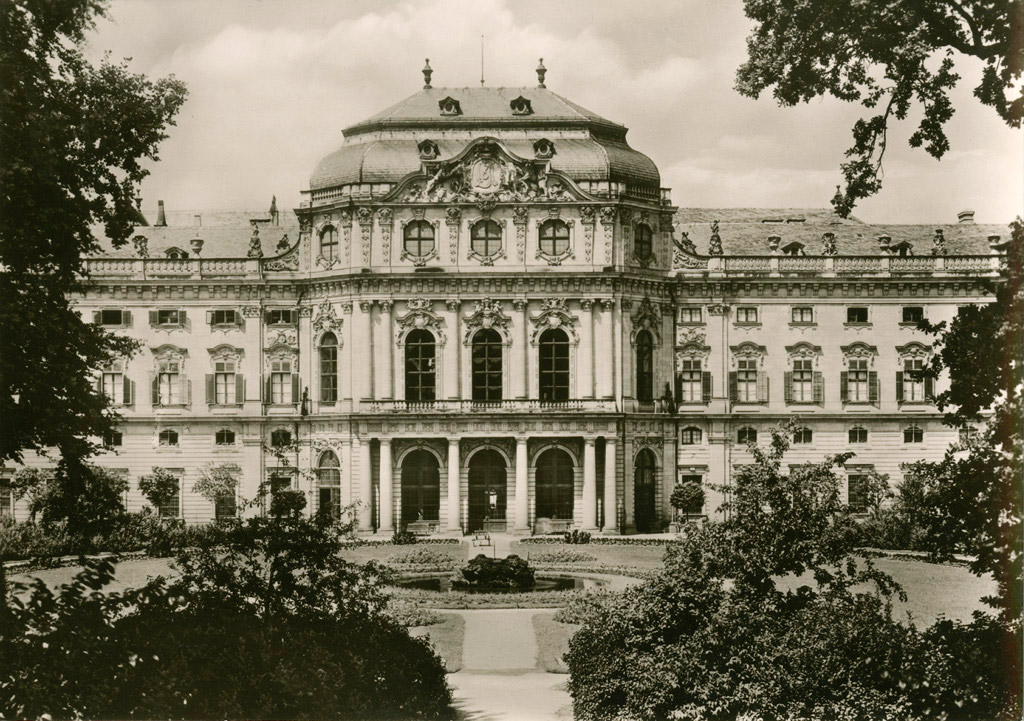
Würzburg (Bayern, Germany). Furstbischofliche Residenz, garden façade. Built from 1720 to 1780, the palace was severely damaged in 1945, and reconstructed from 1945 to 1987. (Rare Postcard Collection)

Würzburg (Bayern, Germany). Furstbischofliche Residenz, staircase by Balthasar Neumann (1687–1753). The ceiling fresco by Giovanni Battista Tiepolo (1696–1770), an allegory of the planets and four continents created from 1752 to 1753, is considered the artist’s highest achievement. Remarkably, it was not damaged by the devastating March 16, 1945 air strike that burnt out most of the Residenz. (Rare Postcard Collection)

Würzburg (Bayern, Germany). Furstbischofliche Residenz, staircase fresco. The fresco by Giovanni Battista Tiepolo (1696–1770) covers an area 59 by 98 feet on the unsupported stone vault ceiling. The stone ceiling protected Tiepolo’s masterpiece from the fire ignited in the roof and attic above it by the 1945 air raid. Later, MFAA Officer John Davis Skilton (1909–1992), a former National Gallery of Art curator, ingeniously organized the building of a temporary roof above the fresco to save it from seeping rainwater. (Photo by Carl Lamb, 1943/1945)

Würzburg (Bayern, Germany). Furstbischofliche Residenz, staircase fresco. In Giovanni Battista Tiepolo’s (1696–1770) fresco, the continent of Europe dominates the other three continents in culture and civilization. Here the allegorical figure representing painting indicates with her brush that Würzburg is the cultural center of Europe. Tiepolo and his son Domenico, in a white wig, look on from the far left. (Photo by Carl Lamb, 1943/1945)

Würzburg (Bayern, Germany). Furstbischofliche Residenz, staircase fresco. In the center, the planets are presented as gods and goddesses from classical mythology, such as Luna the moon goddess pictured here. (Photo by Carl Lamb, 1943/1945)
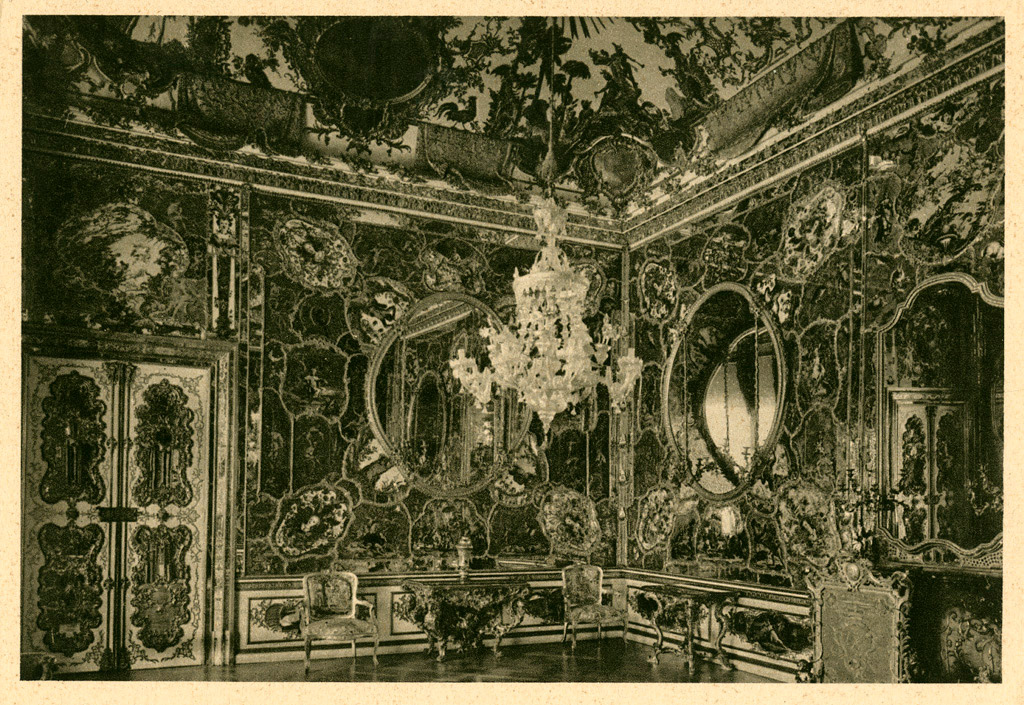
Würzburg (Bayern, Germany). Furstbischofliche Residenz, Mirror Cabinet. Completed from 1740 to 1745, this precious room was one of the most original interiors created for the Würzburg Residenz. It was completely destroyed when roof fires caused by the Allied air raid of 1945 spread down through wood ceilings and floors from the attic. (Rare Postcard Collection)

Würzburg (Bayern, Germany). Furstbischofliche Residenz, Mirror Cabinet. This corner of the ceiling was decorated with gilded stucco and a painted relief of an allegory of Asia. (Photo by Carl Lamb, 1943/1945)

Würzburg (Bayern, Germany). Furstbischofliche Residenz, Mirror Cabinet. Personage on a Palanquin borne by Jesters, 1740s, reverse painting on glass with verre églomisé archers in the upper corners. (Photo by Carl Lamb, 1943/1945)